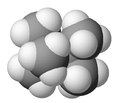 | |
 | |
| Names | |
|---|---|
| Preferred IUPAC name 2,2,3,3-Tetramethylbutane [1] | |
| Identifiers | |
3D model (JSmol) | |
| ChemSpider | |
| ECHA InfoCard | 100.008.961 |
| EC Number |
|
PubChem CID | |
| UNII | |
| UN number | 1325 |
CompTox Dashboard (EPA) | |
| |
| |
| Properties | |
| C8H18 | |
| Molar mass | 114.232 g·mol−1 |
| Appearance | White, opaque, waxy crystals |
| Odor | Odorless |
| Melting point | 98 to 104 °C; 208 to 219 °F; 371 to 377 K |
| Boiling point | 106.0 to 107.0 °C; 222.7 to 224.5 °F; 379.1 to 380.1 K |
Henry's law constant (kH) | 2.9 nmol Pa−1 kg−1 |
| Thermochemistry | |
Heat capacity (C) | 232.2 J K−1 mol−1 (at 2.8 °C) |
Std molar entropy (S⦵298) | 273.76 J K−1 mol−1 |
Std enthalpy of formation (ΔfH⦵298) | −270.3 – −267.9 kJ mol−1 |
Std enthalpy of combustion (ΔcH⦵298) | −5.4526 – −5.4504 MJ mol−1 |
| Hazards | |
| GHS labelling: | |
    | |
| Danger | |
| H228, H304, H315, H336, H410 | |
| P210, P240, P241, P261, P264, P271, P273, P280, P301+P310, P302+P352, P304+P340, P312, P321, P331, P332+P313, P362, P370+P378, P391, P403+P233, P405, P501 | |
| Flash point | 4 °C (39 °F; 277 K) |
| Explosive limits | 1–?% |
| Related compounds | |
Related alkanes | |
Except where otherwise noted, data are given for materials in their standard state (at 25 °C [77 °F], 100 kPa). | |
Tetramethylbutane, sometimes called hexamethylethane, is a hydrocarbon with formula C8H18 or (H3C-)3C-C(-CH3)3. It is the most heavily branched and most compact of the octane isomers, the only one with a butane (C4) backbone. Because of its highly symmetrical structure, it has a very high melting point and a short liquid range; in fact, it is the smallest saturated acyclic hydrocarbon that appears as a solid at a room temperature of 25 °C. (Among cyclic hydrocarbons, cubane, C8H8, norbornane, C7H12 and norbornene, C7H10 are even smaller and are also solid at room temperature.) It is also the most stable C8H18 isomer, with a heat of formation 4.18 kcal/mol (17.5 kJ/mol) lower than that of n-octane, a fact that has been attributed to stabilizing dispersive interactions (electron correlation) between the methyl groups (protobranching). [2]
The compound can be obtained from ethyl bromide, tert-butyl bromide, and magnesium metal in the presence of manganese(II) ions. Despite conditions amenable to the formation of a Grignard reagent, organomagnesium compounds are believed not to be the active species. Instead, they transmetalate to organomanganese compounds, which then decompose to tert-butyl radicals, which dimerize. [3]
The full IUPAC name of the compound is 2,2,3,3-tetramethylbutane, but the numbers are superfluous in this case because there is no other possible arrangement of "tetramethylbutane".